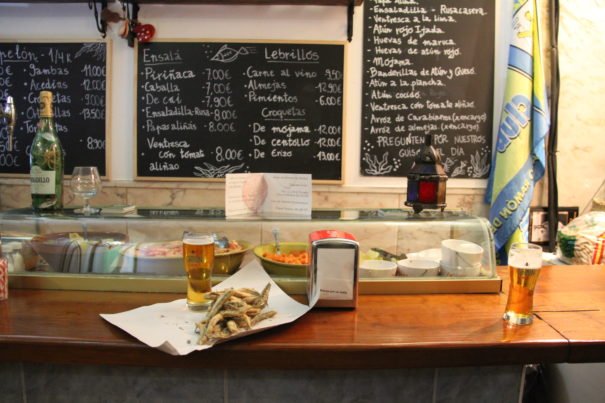
Long Live the Everyman Bar, the Old‑Man Bar, the Grasabar

Long Live the Everyman Bar, the Old‑Man Bar, the Grasabar
Cañas in Madrid
¡Viva el grasabar español! The grasabar is Spanish institution, the traditional everyman bars you can find in all Iberian cities. They are not places overly concerned with design and interior decorating; they have an aesthetic somewhere between retro, shabby, and sloppy. But they are the Swiss Army knife of the hospitality industry: in them, one can have a quick coffee and a croissant, eat a full breakfast spread, grab a sandwich with egg and squid in the afternoon, or dine on tapas and cañas—small glasses of beer—when night falls. The cañas are fundamental to the grasabar: icy cold, pulled perfectly from the tap by the wise hands of expert waiters. There are those that stay open all night to relieve the suffering of late-night taxi drivers and other mysterious creatures of the dawn as they emerge from bars and nightclubs. They serve everything to everyone.
The waiters are usually seasoned veterans, gentlemen in white jackets or black vests who stand behind the metal bar to promptly serve whoever enters. When you step through the door, the waiter shouts, “Young man, what do you want?” In the grasabares, you are always young and able to fulfill (almost) all of your desires.
Not only your gastronomic desires: here you can read the daily press (especially the sports pages), buy tobacco from a vending machine, watch the news or the football game—perhaps a Western in the afternoon—or throw your life away by gambling, immersed in the joyful lights and melodies of the slot machines. You can also talk to neighbors or strangers, especially about politics; even better, you can eavesdrop on the silly ramblings of others. Because in these places, people of all types, classes, and circumstances meet: the elderly enjoying a glass of wine, ladies coming from the market, young people looking for cheap cañas, and groups of friends meeting after work.
The grasabares are found mainly in villages or in working-class neighborhoods that were built in many Spanish cities during the 60s and 70s, a period of Francoist development. They were once common in city centers as well, but they have a powerful enemy who, like a cancer, spreads far and wide in large cities and metastasizes provincial capitals. This is the modern hipster bar, with its long wooden tables, its organic juices, its vintage light bulbs and armies of freelancers using the Wi-Fi connection to replace an office.
Many entrepreneurs in the restaurant world have very little imagination and are unwilling to take risks. They replicate this model until it is all that is left, overtaking entire neighborhoods, like the gentrified areas of Malasaña or Chueca in Madrid. This version of modernity is posh and boring. That’s why you have to defend the Spanish grasabar, the everyman bar, the traditional bar, the old-man bar. That’s why you have to go and eat piles of pork and drink beer in industrial quantities and forget about cholesterol levels. And that’s why the Spanish government must find a way to protect the few of these establishments that remain.